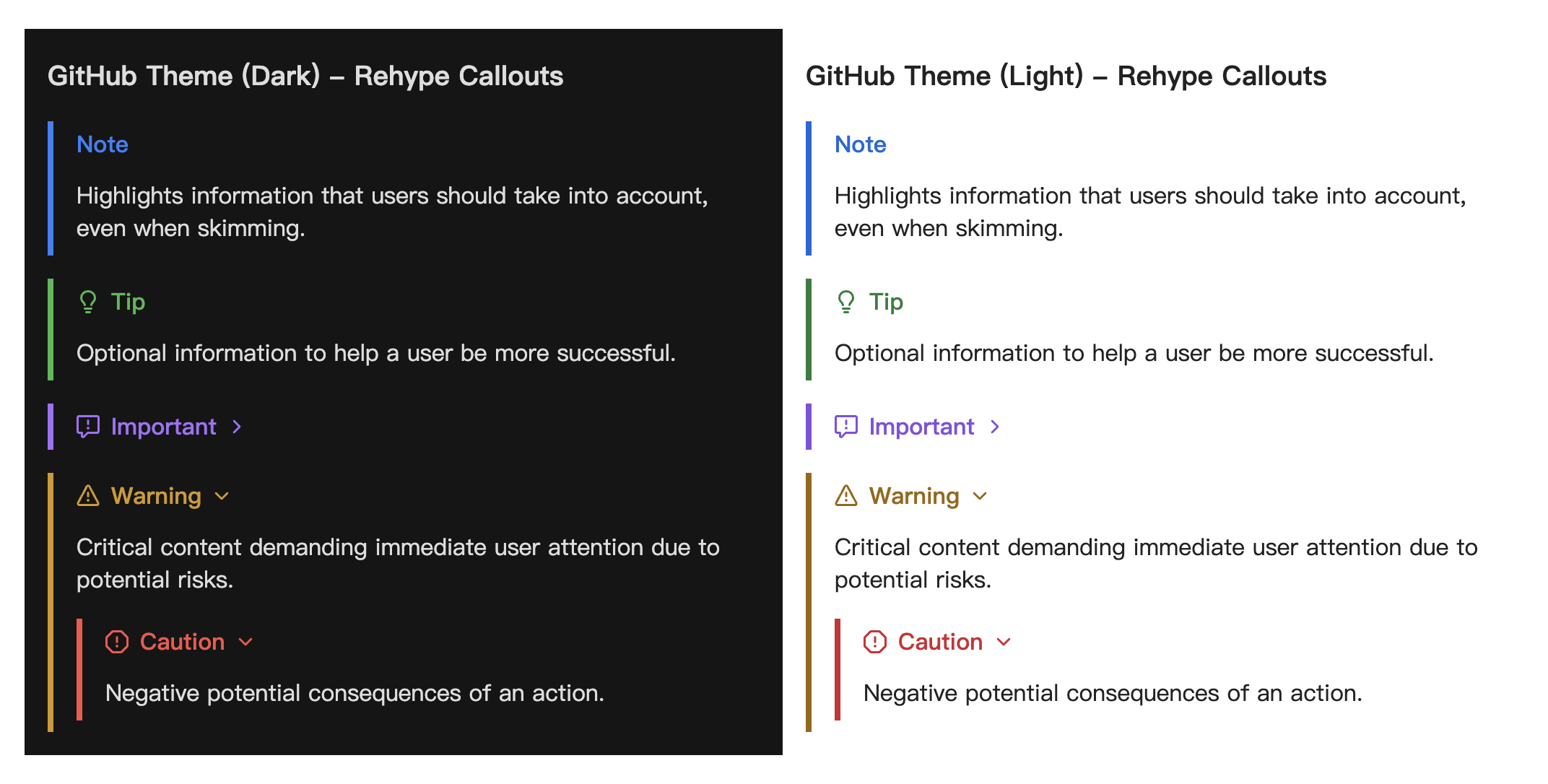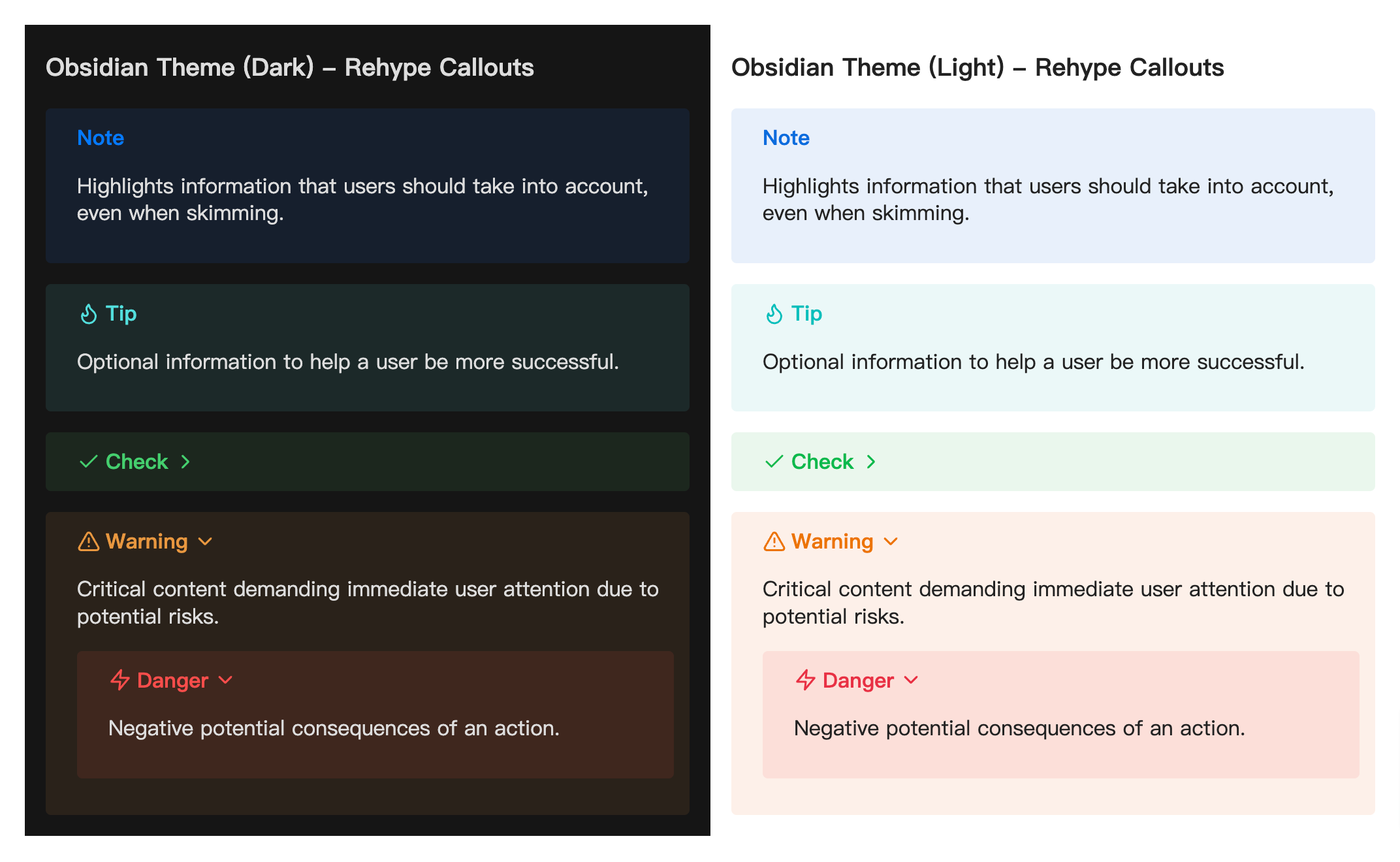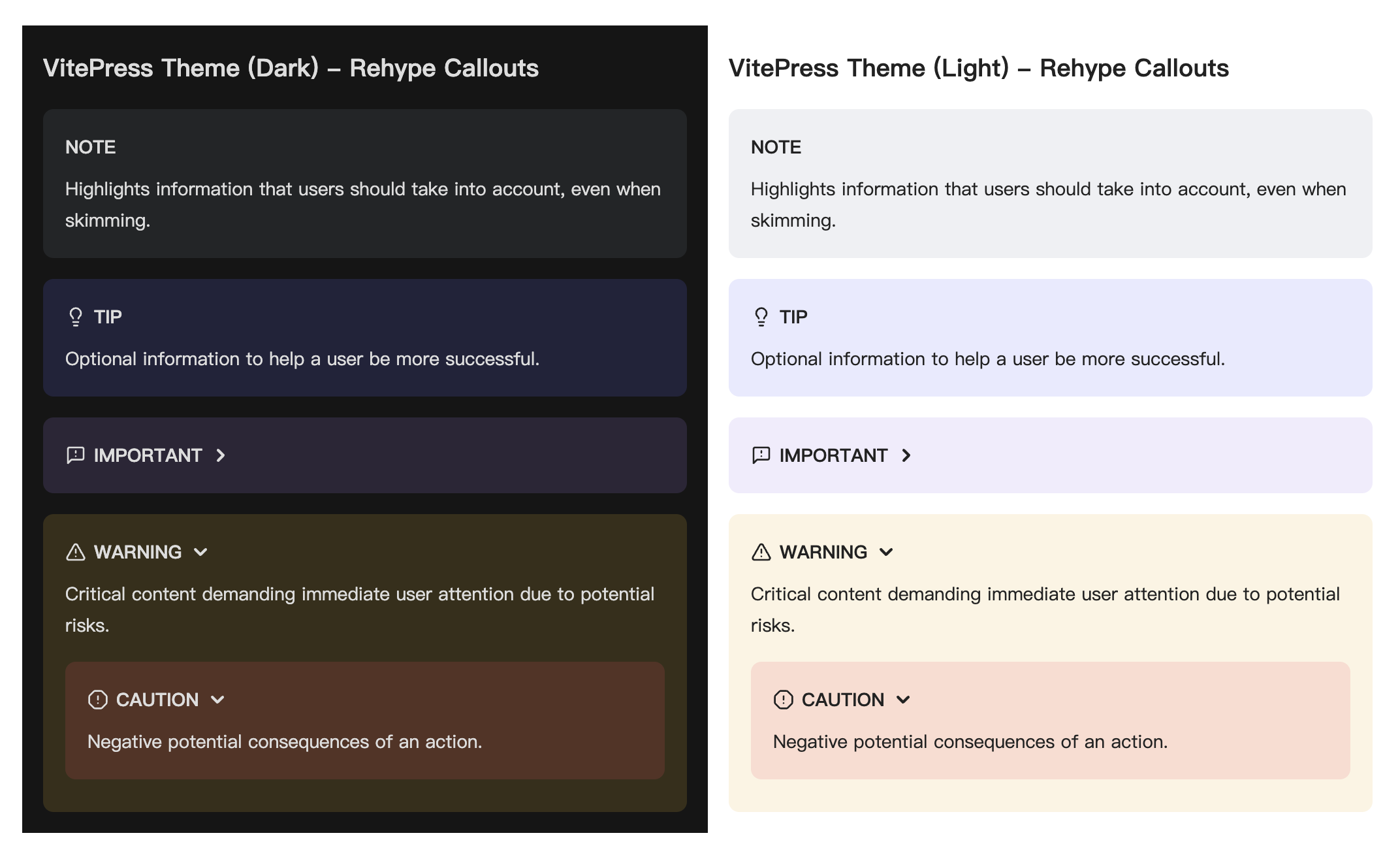A rehype plugin for processing and rendering blockquote-based callouts.
This plugin adds support for callouts (admonitions/alerts), allowing you to use Obsidian's callout syntax to achieve the following features:
- Includes default callout types for various themes.
- Supports collapsible callouts with
-/+and nestable callouts. - Optionally import stylesheets for corresponding themes.
- Allows custom titles with markdown syntax.
- Customizable default callout types.
- Configurable new callout types.
- Configurable aliases for callout types.
- Configurable icon display.
- Configurable element attributes.
This plugin helps render markdown callouts, ideal for blogs built with frameworks like Astro or Next.js. It processes HTML directly without needing allowDangerousHtml in remark-rehype and supports collapsible callouts with the details tag, all without JavaScript.
This package is ESM only. In Node.js (version 18+), install with your package manager:
npm install rehype-callouts
yarn add rehype-callouts
pnpm add rehype-calloutsIn Deno with esm.sh:
import rehypeCallouts from 'https://esm.sh/rehype-callouts'In browsers with esm.sh:
<script type="module">
import rehypeCallouts from 'https://esm.sh/rehype-callouts?bundle'
</script>Say example.md contains:
<!-- Callout type names are case-insensitive: 'Note', 'NOTE', and 'note' are equivalent. -->
> [!note] This is a _non-collapsible_ callout
> Some content is displayed directly!
> [!WARNING]- This is a **collapsible** callout
> Some content shown after opening!For vanilla JS:
// example.js
import { unified } from 'unified'
import remarkParse from 'remark-parse'
import remarkRehype from 'remark-rehype'
import rehypeCallouts from 'rehype-callouts'
import rehypeStringify from 'rehype-stringify'
import { readSync } from 'to-vfile'
const file = unified()
.use(remarkParse)
.use(remarkRehype)
.use(rehypeCallouts)
.use(rehypeStringify)
.processSync(readSync('example.md'))
console.log(String(file))For Astro projects:
// astro.config.ts
import { defineConfig } from 'astro/config'
import rehypeCallouts from 'rehype-callouts'
// https://docs.astro.build/en/reference/configuration-reference/
export default defineConfig({
markdown: {
rehypePlugins: [rehypeCallouts],
},
})For Next.js projects:
// next.config.ts
import createMDX from '@next/mdx'
import rehypeCallouts from 'rehype-callouts'
import type { NextConfig } from 'next'
// https://nextjs.org/docs/app/api-reference/config/next-config-js
const nextConfig: NextConfig = {
pageExtensions: ['js', 'jsx', 'md', 'mdx', 'ts', 'tsx'],
}
const withMDX = createMDX({
options: {
remarkPlugins: [],
rehypePlugins: [rehypeCallouts],
// With Turbopack, specify plugin names as strings
// rehypePlugins: [['rehype-callouts']],
},
})
export default withMDX(nextConfig)Run node example.js (pnpm dev) to get:
<div class="callout" data-callout="note" data-collapsible="false">
<div class="callout-title">
<div class="callout-title-icon" aria-hidden="true">
<!-- svg icon-->
</div>
<div class="callout-title-text">
This is a <em>non-collapsible</em> callout
</div>
</div>
<div class="callout-content">
<p>Some content is displayed directly!</p>
</div>
</div>
<details class="callout" data-callout="warning" data-collapsible="true">
<summary class="callout-title">
<div class="callout-title-icon" aria-hidden="true">
<!-- svg icon-->
</div>
<div class="callout-title-text">
This is a <strong>collapsible</strong> callout
</div>
<div class="callout-fold-icon" aria-hidden="true">
<!-- svg icon-->
</div>
</summary>
<div class="callout-content">
<p>Some content shown after opening!</p>
</div>
</details>This package exports no identifiers. The default export is rehypeCallouts.
Used to render callouts.
options(UserOptions, optional) — configuration
Transform (Transformer).
Configuration (TypeScript type). All options are optional.
theme('github'|'obsidian'|'vitepress', default:'obsidian') — your desired callout theme to automatically apply its default callout types.callouts(Record<string, CalloutConfig>, default: see source code) — define default or custom callouts as key-value pairs, where each key is a callout type and the value specifies its default text and icon, e.g.,{'note': {title: 'custom title'}, 'custom': {title: 'new callout', indicator: '<svg ...">...</svg>'}}.aliases(Record<string, string[]>, default:{}) — aliases for callout types, e.g.,{'note': ['n'], 'tip': ['t']}.showIndicator(boolean, default:true) — whether to display an type-specific icons before callout title.tags(TagsConfig, default: all set todiv) — HTML tag names for callout structure elements.props(PropsConfig, default: allnull) — properties for callout structure elements, whereclassorclassNameoverrides default class names; see examples below.
You can customize callout styles with the class names or by importing the provided theme-specific stylesheets using one of the following methods.
Import in JavaScript/TypeScript:
import 'rehype-callouts/theme/github'
// import 'rehype-callouts/theme/obsidian'
// import 'rehype-callouts/theme/vitepress'Import in a CSS file:
@import 'rehype-callouts/theme/github';Import in a Sass file:
@use 'rehype-callouts/theme/github';Directly include in HTML via CDN (unpkg.com or jsdelivr.net):
<link
rel="stylesheet"
href="https://unpkg.com/rehype-callouts/dist/themes/github/index.css"
/>
<link
rel="stylesheet"
href="https://cdn.jsdelivr.net/npm/rehype-callouts/dist/themes/github/index.css"
/>Once imported, you can set colors for default or custom callouts as follows:
/* Using CSS custom properties (for default callouts only) */
:root {
--callout-note-color-light: pink;
--callout-note-color-dark: #ffc0cb;
--callout-tip-color-light: rgb(255, 192, 203);
--callout-tip-color-dark: hsl(350, 100%, 88%);
/* Customize colors for default callout types included in the theme
using `--callout-{type}-color-{light|dark}: <color>` */
}
/* Using attribute selectors (for both default and custom callouts) */
/* Custom callouts default to `#888` if no color is set */
[data-callout='warning'],
[data-callout='custom'] {
--rc-color-light: pink;
--rc-color-dark: #ffc0cb;
}This package provides callout styles for GitHub, Obsidian, and VitePress, with dark mode support via the .dark class. For more, check the source code.
The props option allows overriding the default class names generated by the plugin. The example from before can be changed like so:
import rehypeCallouts from 'rehype-callouts'
...
const file = unified()
.use(remarkParse)
.use(remarkRehype)
- .use(rehypeCallouts)
+ .use(rehypeCallouts, {
+ props: {
+ contentProps: { class: 'custom-class1' },
+ titleProps: { className: ['custom-class2', 'custom-class3'] },
+ },
+ })
.use(rehypeStringify)
.processSync(readSync('example.md'))
console.log(String(file))…that would output:
<div class="callout" data-callout="note" data-collapsible="false">
- <div class="callout-title">
+ <div class="custom-class2 custom-class3">
<div class="callout-title-icon" aria-hidden="true">
<!-- svg icon-->
</div>
<div class="callout-title-text">
This is a <em>non-collapsible</em> callout
</div>
</div>
- <div class="callout-content">
+ <div class="custom-class1">
<p>Some content is displayed directly!</p>
</div>
</div>
<details class="callout" data-callout="warning" data-collapsible="true">
- <summary class="callout-title">
+ <summary class="custom-class2 custom-class3">
<div class="callout-title-icon" aria-hidden="true">
<!-- svg icon-->
</div>
<div class="callout-title-text">
This is a <strong>collapsible</strong> callout
</div>
<div class="callout-fold-icon" aria-hidden="true">
<!-- svg icon-->
</div>
</summary>
- <div class="callout-content">
+ <div class="custom-class1">
<p>Some content shown after opening!</p>
</div>
</details>The props option allows adding custom attributes to elements in generated callouts. The example from before can be changed to add the dir: auto attribute to the outer container of both collapsible and non-collapsible callouts, and to set a custom color for 'note' callouts, like so:
import rehypeCallouts from 'rehype-callouts'
...
const file = unified()
.use(remarkParse)
.use(remarkRehype)
- .use(rehypeCallouts)
+ .use(rehypeCallouts, {
+ props: {
+ containerProps(_, type) {
+ const newProps: Record<string, string> = {
+ dir: 'auto',
+ }
+ if (type === 'note') {
+ newProps.style = '--rc-color-light:#fc7777; --rc-color-dark:#fa9292;'
+ }
+ return newProps
+ },
+ },
+ })
.use(rehypeStringify)
.processSync(readSync('example.md'))
console.log(String(file))…that would output:
<div
+ dir="auto"
+ style="--rc-color-light:#fc7777; --rc-color-dark:#fa9292;"
class="callout"
data-callout="note"
data-collapsible="false"
>
<div class="callout-title">
<div class="callout-title-icon" aria-hidden="true">
<!-- svg icon-->
</div>
<div class="callout-title-text">
This is a <em>non-collapsible</em> callout
</div>
</div>
<div class="callout-content">
<p>Some content is displayed directly!</p>
</div>
</div>
<details
+ dir="auto"
class="callout"
data-callout="warning"
data-collapsible="true"
>
<summary class="callout-title">
<div class="callout-title-icon" aria-hidden="true">
<!-- svg icon-->
</div>
<div class="callout-title-text">
This is a <strong>collapsible</strong> callout
</div>
<div class="callout-fold-icon" aria-hidden="true">
<!-- svg icon-->
</div>
</summary>
<div class="callout-content">
<p>Some content shown after opening!</p>
</div>
</details>Note: In Svelte, using dir="auto" may trigger a compiler error. See #15126 for details.
This package is fully typed with TypeScript. It exports the additional types UserOptions, CalloutConfig, TagsConfig, PropsConfig and CreateProperties. See jsDocs.io for type details.
- staticnoise/rehype-obsidian-callout - basic functionality.
- Octions - default icons for GitHub callouts.
- Lucide - default icons for Obsidian, VitePress callouts.
If you see any errors or room for improvement on this plugin, feel free to open an issues or pull request . Thank you in advance for contributing!
MIT © 2024-PRESENT Stephanie Lin






